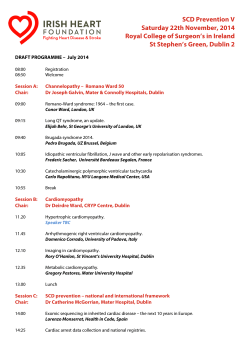
Cardiac involvement of primary hyperoxaluria accompanied by non
Türk Kardiyol Dern Arş - Arch Turk Soc Cardiol 2015;43(3):288-291 doi: 10.5543/tkda.2015.46026 288 Cardiac involvement of primary hyperoxaluria accompanied by non-compaction cardiomyopathy and patent ductus arteriosus Kalp tutulumu olan primer hiperoksalürili bir olguda patent duktus arteriyozusun eşlik ettiği non kompaksiyon kardiyomiyopati Nurcan Arat, M.D., Murat Akyıldız, M.D.,# Gürkan Tellioğlu, M.D.,* Yaman Tokat, M.D.† Department of Cardiology, Istanbul Bilim University Faculty of Medicine, Istanbul # Department of Gastroenterology, Istanbul Bilim University Faculty of Medicine, Istanbul *Department of Renal Transplantation, Sisli Florence Nightingale Hospital, Istanbul † Department of Liver Transplantation, Sisli Florence Nightingale Hospital, İstanbul Summary– Primary hyperoxaluria is a rare hereditary metabolic disorder resulting in accumulation of calcium oxalate in visceral organs, including the heart. We report a 19-year-old male with non- compaction cardiomyopathy combined with patent ductus arteriosus awaiting combined liver-kidney transplantation for primary hyperoxaluria. After surgical closure of the patent ductus arteriosus, the patient underwent a successful renal and subsequent liver transplantation. The presence of hypertrophic cardiomyopathy in hyperoxaluria patients has been reported before, but this is the first report of non-compaction myocardium with patent ductus arteriosus in a patient with primary hyperoxaluria. At the third month after combined liver and renal transplantation, improvement in cardiac functions were observed. Primary hyperoxaluria is a clinical entity to be taken into consideration in differential diagnosis of hypertrophied myocardium with high myocardial echocardiographic intensity. In cases of hyperoxaluria, additional congenital abnormalities may complicate the clinical picture. P rimary hyperoxaluria is a rare hereditary metabolic disorder that leads to accumulation of calcium oxalate in visceral organs. Although clinical symptoms are often associated with the kidney, calcium oxalate can accumulate in all tissues, including the heart.[1,2] Here, for the first time we report a case of Özet– Primer hiperoksalüri kalp de dahil olmak üzere iç organlarda, kalsiyum oksalat birikimi ile sonuçlanan nadir görülen kalıtsal metabolik bir hastalıktır. Bu yazıda, primer hiperoksalüri nedeniyle kombine karaciğer ve böbrek nakli planlanan 19 yaşında erkek hastada, non kompaksiyon kardiyomiyopatiyle birlikte patent duktus arteriyozusun eşlik ettiği hiperoksalürinin kalp tutulumu sunuldu. Patent duktus arteriyozus cerrahi olarak kapatılarak hastaya önce böbrek ve takiben karaciğer nakli başarıyla uygulandı. Hiperoksalüri ile birlikte hipertrofik kardiyomiyopati daha önce bildirilmiştir, ancak bizim olgumuzdaki gibi patent duktus arteriyozus ve non kompaksiyon kardiyomiyopati varlığı primer hiperoksalürili hastalarda bu olguyla ilk kez bildirilmektedir. Kalp tutulumu olan hiperoksalürili olguda kombine karaciğer ve böbrek nakli sonrasında üçüncü ayda kalp fonksiyonlarında iyileşme gözlendi. Primer hiperoksalüri, miyokartta artmış eko yoğunluğunun eşlik ettiği ventrikül hipertrofisinin ekokardiyografik ayırıcı tanısında dikkate alınması gereken bir klinik tablodur. Hiperoksalürili olgularda doğuştan gelen ek anomaliler klinik durumu zorlaştırabilir. cardiac involvement; a non- Abbreviation: compacted cardiomyopathy PDA Patent ductus arteriosus associated with patent ductus arteriosus (PDA) in a patient with primary hyperoxaluria. The echocardiographic findings are presented. Received: October 03, 2014 Accepted: February 02, 2015 Correspondence: Dr. Nurcan Arat. İstanbul Cad., Zenginbahçe Konutları 1, Göktürk, Eyüp, 34075 İstanbul. Tel: +90 212 - 212 88 11 e-mail: aratnurcan@gmail.com © 2015 Turkish Society of Cardiology Non-compaction cardiomyopathy and patent ductus arteriosus CASE REPORT A 19-year-old male patient with a diagnosis of primary hyperoxaluria and evaluation for liver-kidney transplantation was referred to the cardiology clinic for preoperative cardiac evaluation. His history showed that he had developed progressive renal failure secondary to nephrolithiasis, and 5 years previously had undergone a left nephrectomy. Hemodialysis had started 2 years prior to admission. The patient had no cardiac symptoms other than fatigue. He had a family history of consanguineous parents, and hyperoxaluria was diagnosed in his two siblings on family screening. Physical examination revealed blood pressure of 100/60 mmHg and heart rate of 72/min. Heart sounds were diminished and there was a continuous 3rd degree murmur with spreading to the back of the pulmonary area. A pansystolic 2/6 degree murmur on mitral and tricuspid focus was present. Electrocardiography revealed sinus rhythm (Fig 1). Transthoracic echocardiography revealed increased granular echo density on the interventricular septum (Fig. 2a). Compacted and non-compacted spongy trabecular meshwork, more pronounced in the left ventricular apical region, was detected (Fig. 2b). There was mild enlargement of left ventricular diameter and left ventricular systolic function was mildly impaired (EF 47%). The right ventricle was slightly hypertrophied and enlarged. There was mild pericardial effusion and both atria were significantly 289 enlarged. Doppler echocardiography showed severe tricuspid regurgitation and increased pulmonary artery systolic pressure (42 mmHg). Doppler echocardiography was also consistent with impaired diastolic filling pattern. A large PDA and moderate left-to-right shunt was detected by echocardiography (Fig. 2c), and confirmed by cardiac catheterization (Fig. 2d). Percutaneous closure of the PDA was not possible because of the anatomy of the ductus, so it was completely closed surgically. The patient underwent successful kidney and liver transplantation four months after the cardiac operation. The pericardial effusion disappeared and improvement in cardiac diameters and systolic function (left ventricular end systolic diameter decreased from 4.9 cm to 4.2 cm and EF increased from 47% to 58%) was observed on echocardiographic evaluation at the 3rd postoperative month. Echocardiographic screening of his two asymptomatic hyperoxaluric siblings revealed only an increase in myocardial echo density in a granular manner, and no apparent structural or functional cardiac abnormalities were found. DISCUSSION Primary hyperoxaluria is a rare autosomal-recessive disorder characterized by increased urinary excretion of calcium oxalate, recurrent urolithiasis, nephrocalcinosis, and accumulation of insoluble oxalate throughout the body (oxalosis).[3-5] Patients are initially diagnosed with renal failure and subsequently have the symptoms and signs of oxalosis. Major sites of deposition include bone, bone marrow, heart, blood vessels, joints, male urogenital system, central nervous system, peripheral nerves, skin and soft tissues. Most patients die as a result of uremia before or during the third decade. Even in industrialized countries, there is a high rate of late diagnosis in advanced renal failure or after kidney graft failure in the setting of isolated kidney transplantation (up to 40% in adults), which denotes underreporting.[6] In severe cases, or in order to correct liver and kidney damage, combined liver-kidney transplantation to correct the enzyme deficiency is the only viable alternative.[5] Figure 1. Twelve-lead ECG recording shows sinus rhythm with left axis deviation and non-specific ST-T wave changes in D1, aVL leads. In hyperoxaluria patients who have limited survival, cardiac abnormalities such as sudden arrhythmias and heart blocks,[7] coronary and peripheral vascular Türk Kardiyol Dern Arş 290 A C B D Figure 2. (A) Two-dimensional transthoracic echocardiography shows severe myocardial hypertrophy with granular, dense echo in inter ventricular septum (arrows) and an enlarged left atrium (LA) and left ventricle (LV) on the left ventricular apical 3-chamber view. (B) Transthoracic color Doppler echocardiography shows the flow observed in the non-compacted myocardial walls (arrows) in left ventricular (LV) apical segments on apical modified long-axis view. (C) Color M-mode echocardiography in suprasternal view shows the continuous flow in the PDA (arrow) at the junction of the descending aorta. (D) PDA (arrow) shown in aortography. involvement,[1,8] atrial mass, increase in left ventricular mass index, hypertrophic cardiomyopathy,[9] left atrial enlargement, pulmonary hypertension and diastolic dysfunction, decreased ejection fraction, infiltrative status and valve pathologies and right ventricular function deterioration have all been previously reported. However, PDA and non-compaction cardiomyopathy in a patient with hyperoxaluria have not been encountered in the current literature. There are several reports indicating improvement in cardiac function in patients with hyperoxaluria after a combined liver and kidney transplantation, as occurred in our case. [2,10] Echocardiographic examination at the 3rd postoperative month showed that left ventricular ejection fraction had increased to 62%, pericardial effusion had disappeared and pulmonary artery pressure had decreased. Pericardial effusion and left ventricular systolic functional improvement is thought to be due to the impact of the actual volume overload change as a result of elimination of both the PDA and renal failure. Primary hyperoxaluria is a clinical condition which should be considered in the differential diagnosis of ventricular hypertrophy accompanied by increased echo density on echocardiography. The clinical picture and differential diagnosis can be complicated in a patient with a combination of such congenital anomalies and hyperoxaluria. Conflict-of-interest issues regarding the authorship or article: None declared. Non-compaction cardiomyopathy and patent ductus arteriosus REFERENCES 1. Bogle MA, Teller CF, Tschen JA, Smith CA, Wang A. Primary hyperoxaluria in a 27-year-old woman. J Am Acad Dermatol 2003;49:725-8. CrossRef 2.Cochat P. Primary hyperoxaluria type 1. Kidney Int 1999;55:2533-47. CrossRef 3. Cochat P, Deloraine A, Rotily M, Olive F, Liponski I, Deries N. Epidemiology of primary hyperoxaluria type 1. Société de Néphrologie and the Société de Néphrologie Pédiatrique. Nephrol Dial Transplant 1995;10 Suppl 8:3-7. CrossRef 4. Danpure CJ, Jennings PR, Penketh RJ, Wise PJ, Cooper PJ, Rodeck CH. Fetal liver alanine: glyoxylate aminotransferase and the prenatal diagnosis of primary hyperoxaluria type 1. Prenat Diagn 1989;9:271-81. CrossRef 5. Kemper MJ. Concurrent or sequential liver and kidney transplantation in children with primary hyperoxaluria type 1? Pediatr Transplant 2005;9:693-6. CrossRef 6. Hoppe B, Langman CB. A United States survey on diagnosis, treatment, and outcome of primary hyperoxaluria. Pediatr Nephrol 2003;18:986-91. CrossRef 291 7. Quan KJ, Biblo LA. Type I primary hyperoxaluria: an unusual presentation of ventricular tachycardia. Cardiol Rev 2003;11:318-9. CrossRef 8. Marconi V, Mofid MZ, McCall C, Eckman I, Nousari HC. Primary hyperoxaluria: report of a patient with livedo reticularis and digital infarcts. J Am Acad Dermatol 2002;46(2 Suppl Case Reports):16-8. 9. Mookadam F, Smith T, Jiamsripong P, Moustafa SE, Monico CG, Lieske JC, et al. Cardiac abnormalities in primary hyperoxaluria. Circ J 2010;74:2403-9. CrossRef 10.McDonald JC, Landreneau MD, Rohr MS, DeVault GA Jr. Reversal by liver transplantation of the complications of primary hyperoxaluria as well as the metabolic defect. N Engl J Med 1989;321:1100-3. CrossRef Key words: Congenital abnormalities; ductus arteriosus, patent; hyperoxaluria, primary; kidney transplantation; liver transplantation. Anahtar sözcükler: Doğumsal anomaliler; patent duktus arteriyozus; hiperoksalüri, birincil; böbrek transplantasyonu; karaciğer transplantasyonu.
© Copyright 2025









